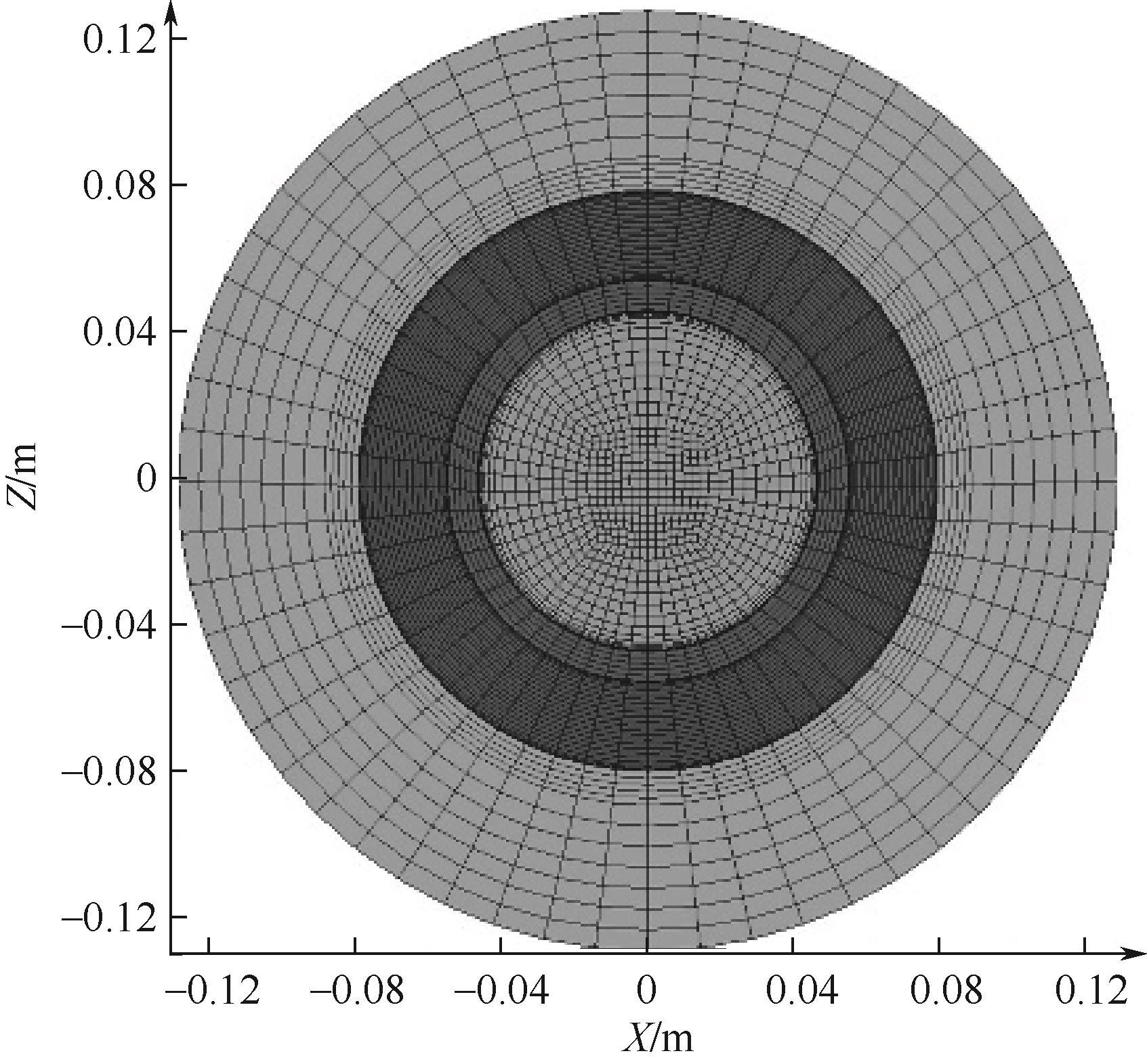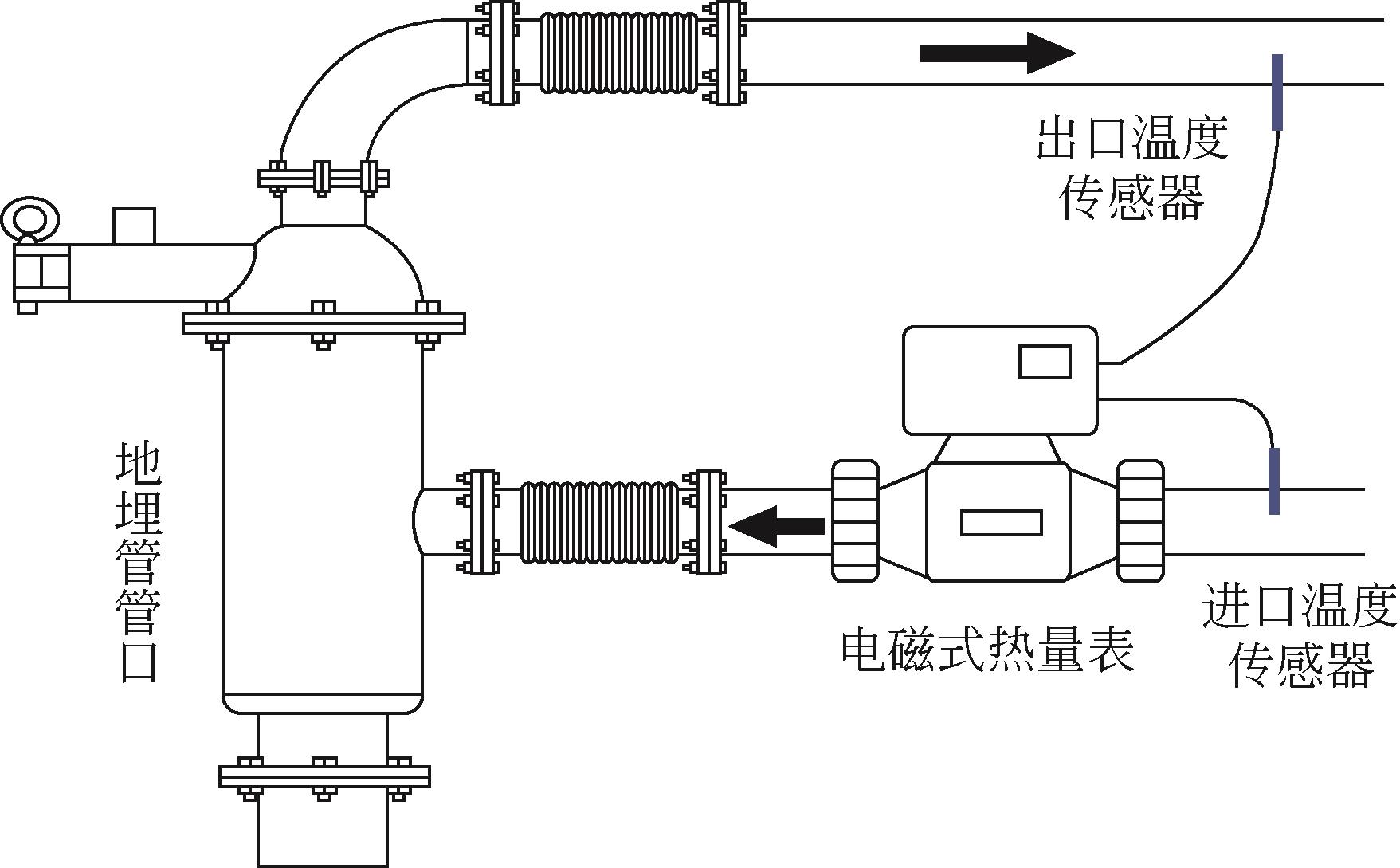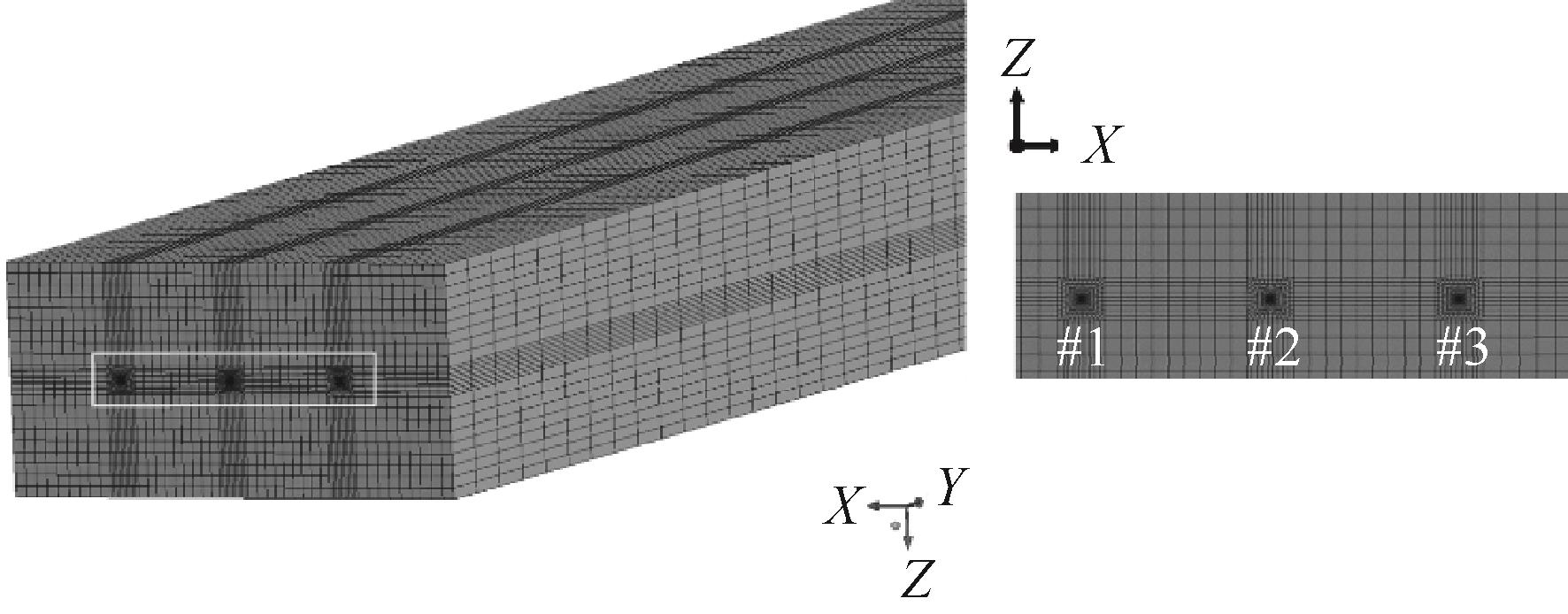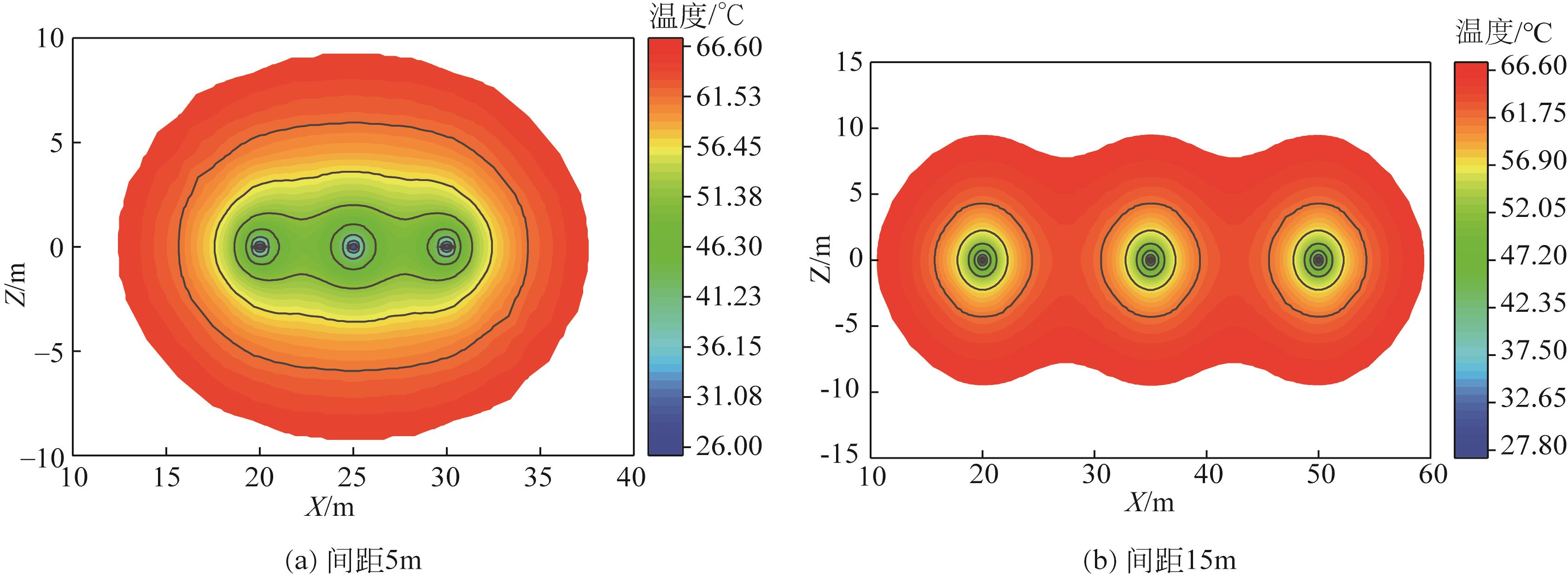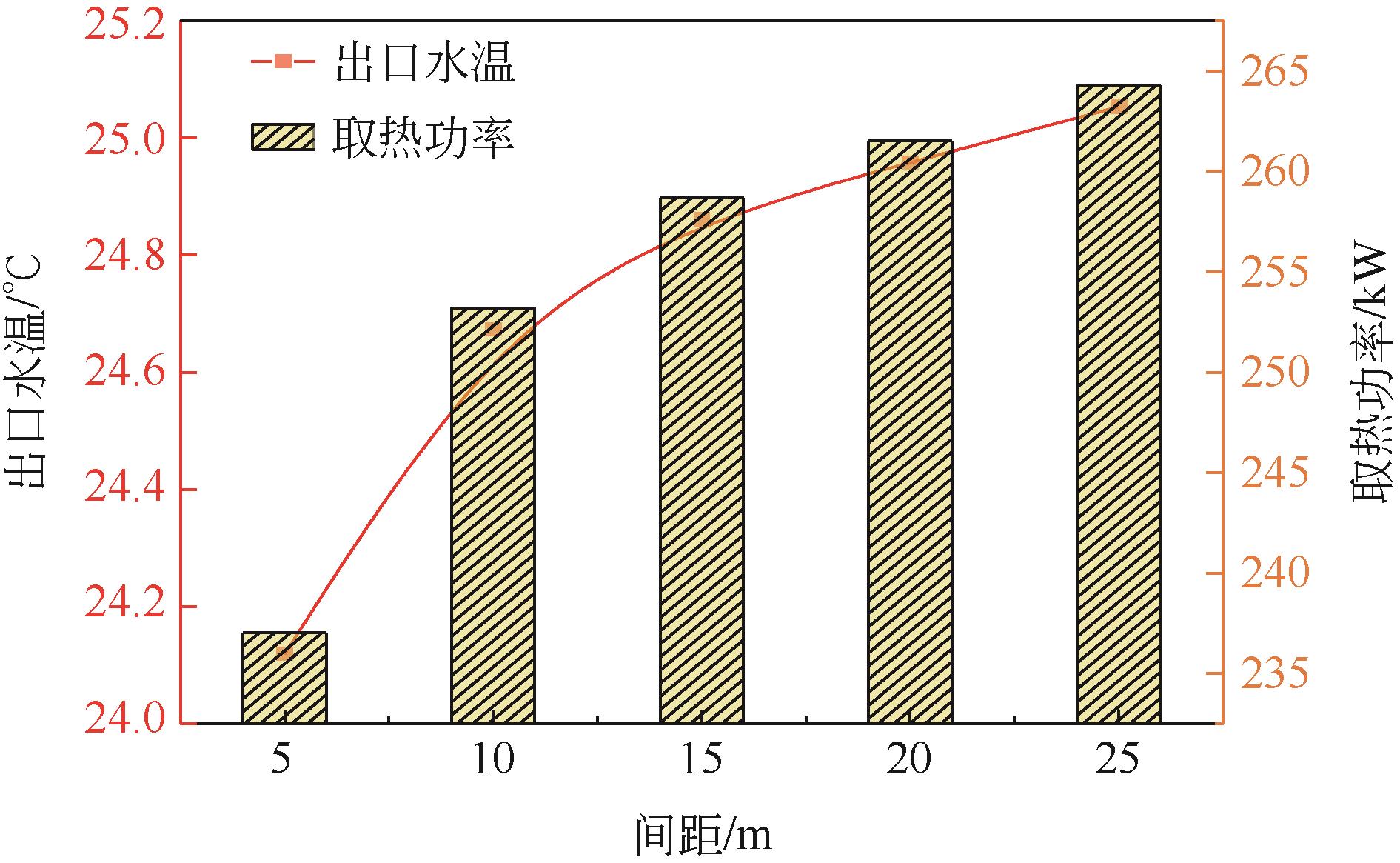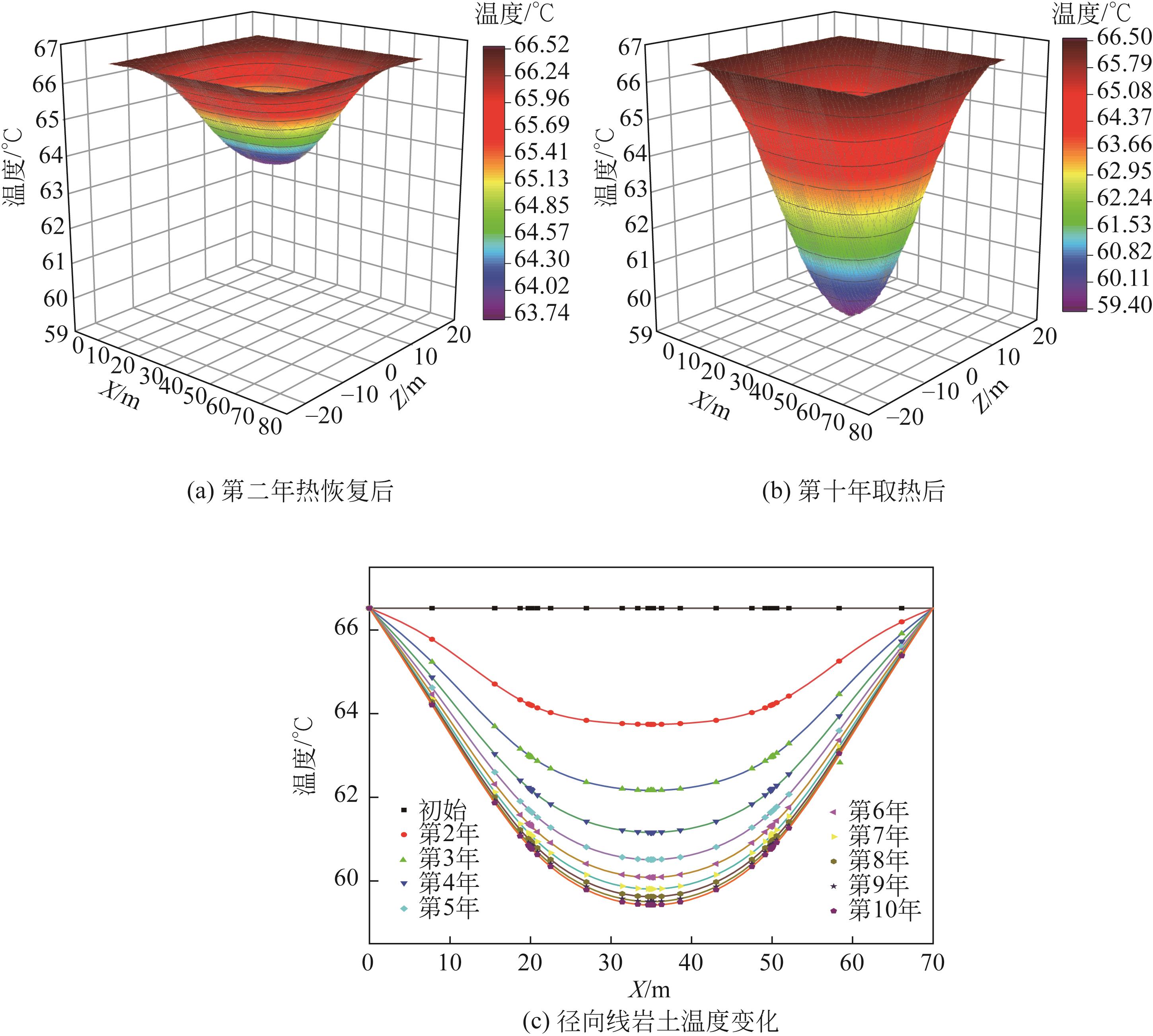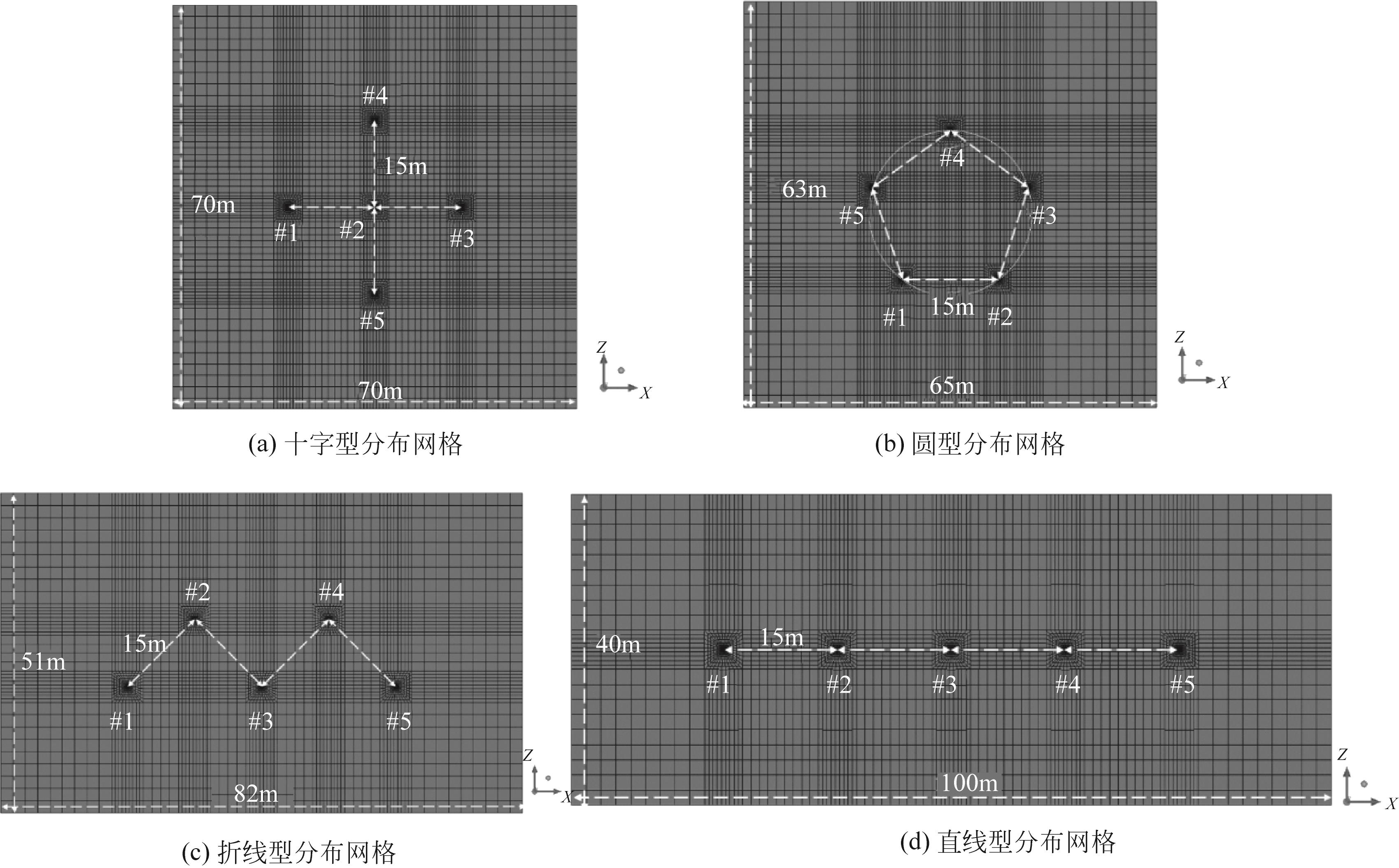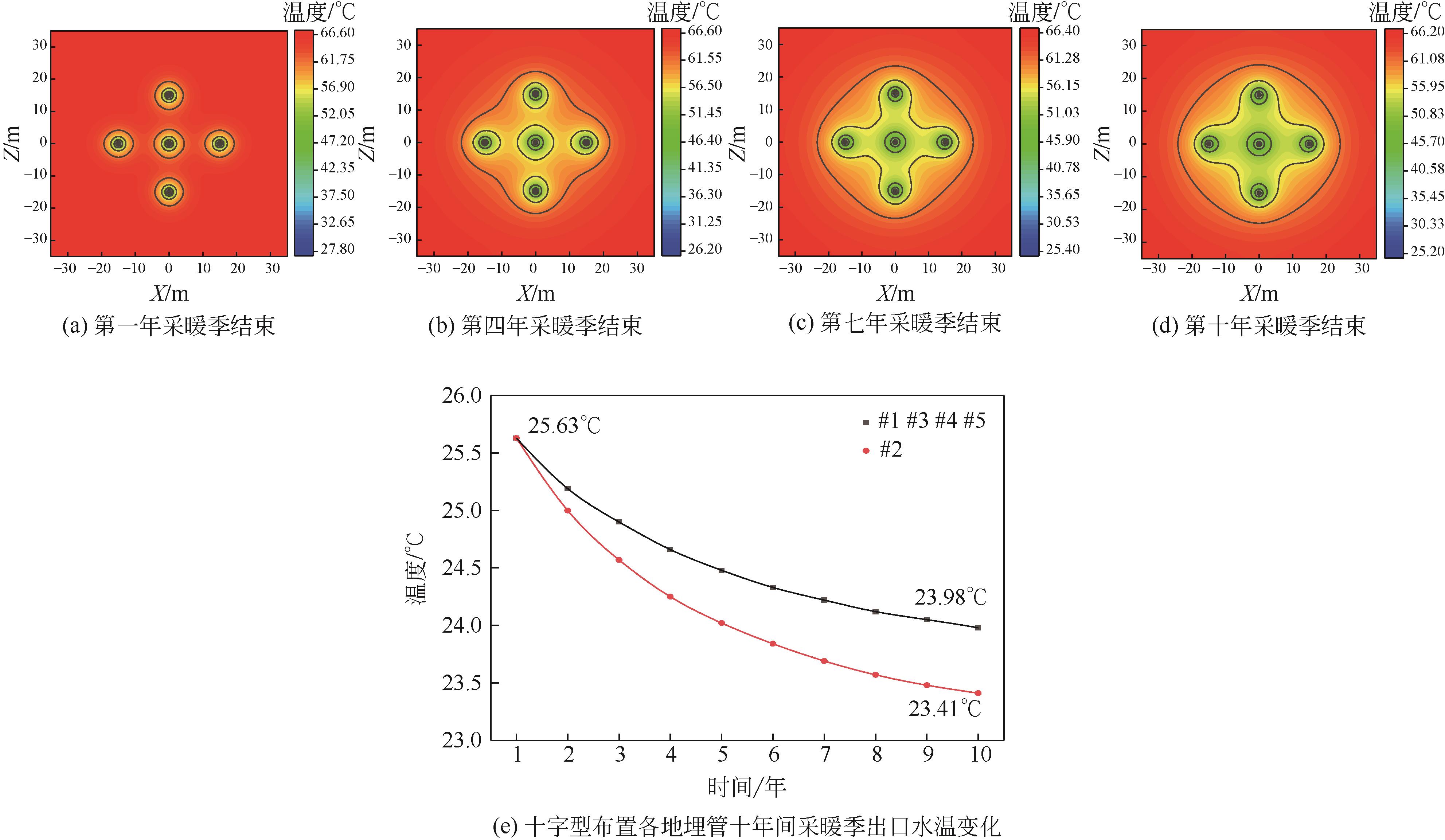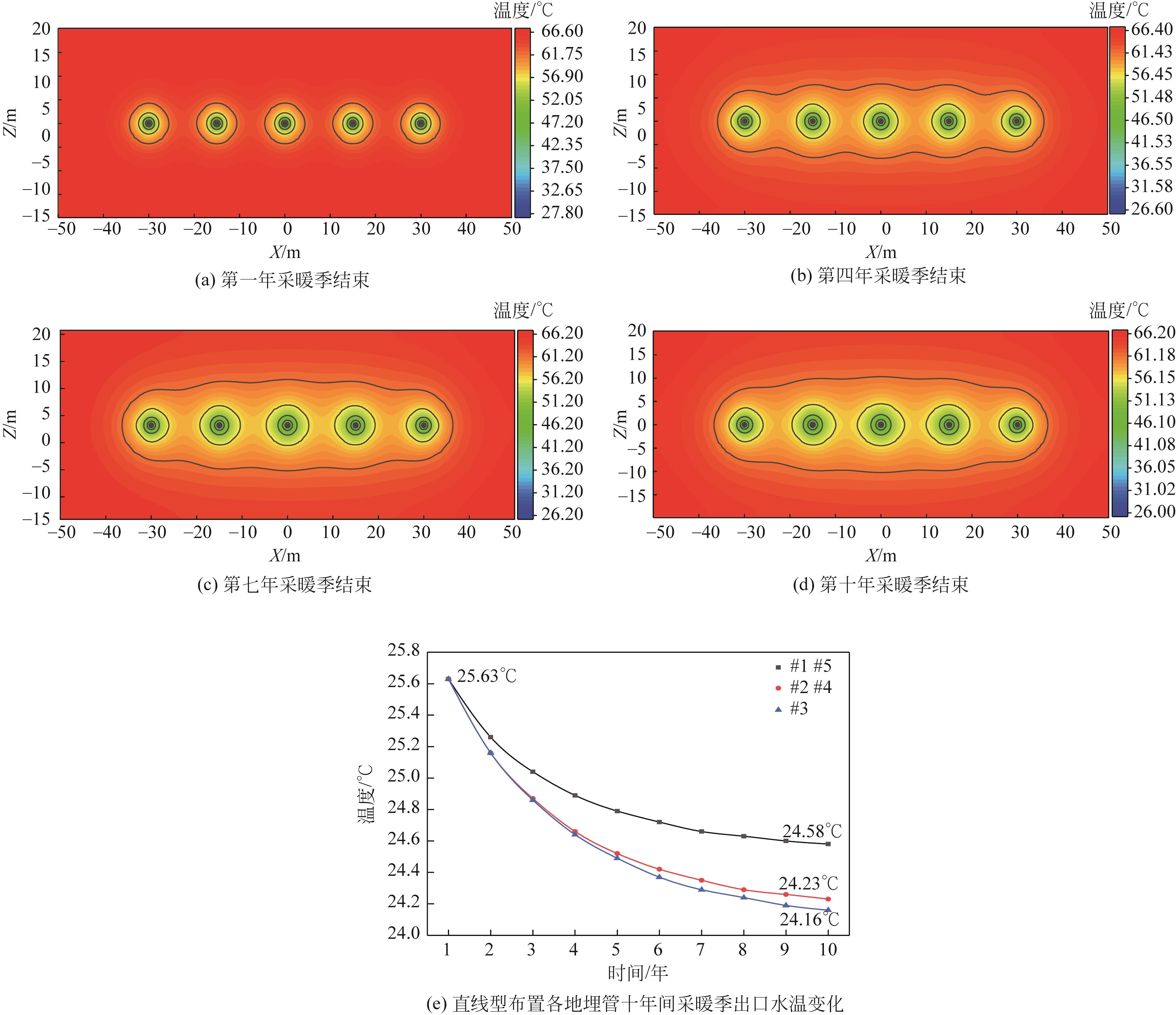Chemical Industry and Engineering Progress ›› 2024, Vol. 43 ›› Issue (3): 1241-1251.DOI: 10.16085/j.issn.1000-6613.2023-0501
• Energy processes and technology • Previous Articles
Heat transfer performance simulation and optimization of deep borehole heat exchanger array
CHEN Hongfei( ), YANG Fuxin(
), YANG Fuxin( ), TAN Houzhang, CAO Jingyu, WU Shengyuan
), TAN Houzhang, CAO Jingyu, WU Shengyuan
- MOE Key Laboratory of Thermo-Fluid Science and Engineering, Xi’an Jiaotong University, Xi’an 710049, Shaanxi, China
-
Received:2023-03-31Revised:2023-08-24Online:2024-04-11Published:2024-03-10 -
Contact:YANG Fuxin
中深层地热地埋管管群换热性能模拟和布置优化
- 西安交通大学热流科学与工程教育部重点实验室,陕西 西安 710049
-
通讯作者:杨富鑫 -
作者简介:陈宏飞(1997—),男,硕士研究生,研究方向为中深层地热利用。E-mail:fly1984_2020@163.com。 -
基金资助:国家自然科学基金(51976166)
CLC Number:
Cite this article
CHEN Hongfei, YANG Fuxin, TAN Houzhang, CAO Jingyu, WU Shengyuan. Heat transfer performance simulation and optimization of deep borehole heat exchanger array[J]. Chemical Industry and Engineering Progress, 2024, 43(3): 1241-1251.
陈宏飞, 杨富鑫, 谭厚章, 曹静宇, 吴盛源. 中深层地热地埋管管群换热性能模拟和布置优化[J]. 化工进展, 2024, 43(3): 1241-1251.
share this article
Add to citation manager EndNote|Ris|BibTeX
URL: https://hgjz.cip.com.cn/EN/10.16085/j.issn.1000-6613.2023-0501
| 井深/m | 岩性 | 井深/m | 岩性 |
|---|---|---|---|
| 200 | 灰绿色泥岩 | 1520 | 灰绿色泥岩 |
| 260 | 灰绿色泥岩 | 1625 | 紫红色细砂岩 |
| 365 | 灰绿色泥岩 | 1625 | 紫红色细砂岩 |
| 470 | 灰绿色泥岩 | 1730 | 紫红色细砂岩 |
| 575 | 灰绿色泥岩 | 1835 | 紫红色细砂岩 |
| 680 | 灰绿色泥岩 | 1940 | 紫红色细砂岩 |
| 785 | 紫红色细砂岩 | 2045 | 紫红色细砂岩 |
| 890 | 紫红色细砂岩 | 2150 | 灰绿色泥岩 |
| 995 | 紫红色细砂岩 | 2255 | 灰绿色泥岩 |
| 1100 | 紫红色细砂岩 | 2360 | 灰绿色泥岩 |
| 1205 | 紫红色细砂岩 | 2465 | 灰绿色泥岩 |
| 1310 | 灰绿色泥岩 | 2510 | 紫红色细砂岩 |
| 1415 | 灰绿色泥岩 |
| 井深/m | 岩性 | 井深/m | 岩性 |
|---|---|---|---|
| 200 | 灰绿色泥岩 | 1520 | 灰绿色泥岩 |
| 260 | 灰绿色泥岩 | 1625 | 紫红色细砂岩 |
| 365 | 灰绿色泥岩 | 1625 | 紫红色细砂岩 |
| 470 | 灰绿色泥岩 | 1730 | 紫红色细砂岩 |
| 575 | 灰绿色泥岩 | 1835 | 紫红色细砂岩 |
| 680 | 灰绿色泥岩 | 1940 | 紫红色细砂岩 |
| 785 | 紫红色细砂岩 | 2045 | 紫红色细砂岩 |
| 890 | 紫红色细砂岩 | 2150 | 灰绿色泥岩 |
| 995 | 紫红色细砂岩 | 2255 | 灰绿色泥岩 |
| 1100 | 紫红色细砂岩 | 2360 | 灰绿色泥岩 |
| 1205 | 紫红色细砂岩 | 2465 | 灰绿色泥岩 |
| 1310 | 灰绿色泥岩 | 2510 | 紫红色细砂岩 |
| 1415 | 灰绿色泥岩 |
| 材料 | 密度/kg·m-3 | 比热容/J·kg-1·K-1 | 热导率/W·m-1·K-1 |
|---|---|---|---|
| 高密度聚乙烯管 | 950 | 2300 | 0.42 |
| J55钢管 | 7850 | 498 | 40 |
| 水泥砂浆 | 1791 | 1348 | 2.8 |
| 紫红色砂岩 | 2600 | 878 | 3.662 |
| 灰绿色泥岩(Ⅰ) | 2027 | 1099.39 | 2.767 |
| 灰绿色泥岩(Ⅱ) | 1551 | 1410.02 | 2.662 |
| 材料 | 密度/kg·m-3 | 比热容/J·kg-1·K-1 | 热导率/W·m-1·K-1 |
|---|---|---|---|
| 高密度聚乙烯管 | 950 | 2300 | 0.42 |
| J55钢管 | 7850 | 498 | 40 |
| 水泥砂浆 | 1791 | 1348 | 2.8 |
| 紫红色砂岩 | 2600 | 878 | 3.662 |
| 灰绿色泥岩(Ⅰ) | 2027 | 1099.39 | 2.767 |
| 灰绿色泥岩(Ⅱ) | 1551 | 1410.02 | 2.662 |
取暖 年限 | 温度/℃ | |||||||||
|---|---|---|---|---|---|---|---|---|---|---|
| 5m | 10m | 15m | 20m | 25m | ||||||
| #1 | #2 | #1 | #2 | #1 | #2 | #1 | #2 | #1 | #2 | |
| 1 | 25.21 | 24.95 | 25.59 | 25.57 | 25.60 | 25.60 | 25.60 | 25.59 | 25.59 | 25.58 |
| 2 | 24.55 | 24.22 | 25.11 | 24.94 | 25.23 | 25.17 | 25.26 | 25.23 | 25.33 | 25.28 |
| 3 | 24.24 | 23.9 | 24.83 | 24.61 | 25.01 | 24.87 | 25.09 | 25.01 | 25.17 | 25.09 |
| 4 | 24.06 | 23.71 | 24.66 | 24.41 | 24.86 | 24.7 | 24.96 | 24.85 | 25.06 | 24.95 |
| 5 | 23.95 | 23.61 | 24.54 | 24.28 | 24.77 | 24.58 | 24.88 | 24.73 | 24.98 | 24.86 |
| 6 | 23.89 | 23.54 | 24.47 | 24.2 | 24.7 | 24.49 | 24.82 | 24.65 | 24.94 | 24.78 |
| 7 | 23.85 | 23.5 | 24.42 | 24.14 | 24.65 | 24.43 | 24.78 | 24.6 | 24.9 | 24.73 |
| 8 | 23.82 | 23.47 | 24.39 | 24.11 | 24.62 | 24.39 | 24.75 | 24.56 | 24.87 | 24.69 |
| 9 | 23.81 | 23.45 | 24.37 | 24.08 | 24.59 | 24.36 | 24.73 | 24.53 | 24.85 | 24.66 |
| 10 | 23.80 | 23.44 | 24.35 | 24.07 | 24.58 | 24.35 | 24.71 | 24.51 | 24.84 | 24.64 |
取暖 年限 | 温度/℃ | |||||||||
|---|---|---|---|---|---|---|---|---|---|---|
| 5m | 10m | 15m | 20m | 25m | ||||||
| #1 | #2 | #1 | #2 | #1 | #2 | #1 | #2 | #1 | #2 | |
| 1 | 25.21 | 24.95 | 25.59 | 25.57 | 25.60 | 25.60 | 25.60 | 25.59 | 25.59 | 25.58 |
| 2 | 24.55 | 24.22 | 25.11 | 24.94 | 25.23 | 25.17 | 25.26 | 25.23 | 25.33 | 25.28 |
| 3 | 24.24 | 23.9 | 24.83 | 24.61 | 25.01 | 24.87 | 25.09 | 25.01 | 25.17 | 25.09 |
| 4 | 24.06 | 23.71 | 24.66 | 24.41 | 24.86 | 24.7 | 24.96 | 24.85 | 25.06 | 24.95 |
| 5 | 23.95 | 23.61 | 24.54 | 24.28 | 24.77 | 24.58 | 24.88 | 24.73 | 24.98 | 24.86 |
| 6 | 23.89 | 23.54 | 24.47 | 24.2 | 24.7 | 24.49 | 24.82 | 24.65 | 24.94 | 24.78 |
| 7 | 23.85 | 23.5 | 24.42 | 24.14 | 24.65 | 24.43 | 24.78 | 24.6 | 24.9 | 24.73 |
| 8 | 23.82 | 23.47 | 24.39 | 24.11 | 24.62 | 24.39 | 24.75 | 24.56 | 24.87 | 24.69 |
| 9 | 23.81 | 23.45 | 24.37 | 24.08 | 24.59 | 24.36 | 24.73 | 24.53 | 24.85 | 24.66 |
| 10 | 23.80 | 23.44 | 24.35 | 24.07 | 24.58 | 24.35 | 24.71 | 24.51 | 24.84 | 24.64 |
| 1 | 清华大学建筑节能研究中心. 中国建筑节能年度发展研究报告-2021-城镇住宅专题[M]. 北京: 中国建筑工业出版社, 2021. |
| Building energy conservation research center of Tsinghua University. Annual development research report of building energy efficiency in China 2021(special topics of urban housing)[M]. Beijing: China Architecture & Building Press, 2021. | |
| 2 | 王贵玲, 杨轩, 马凌, 等. 地热能供热技术的应用现状及发展趋势[J]. 华电技术, 2021, 43(11): 15-24. |
| WANG Guiling, YANG Xuan, MA Ling, et al. Status quo and prospects of geothermal energy in heat supply[J]. Huadian Technology, 2021, 43(11): 15-24. | |
| 3 | RYBACH L, PFISTER M. Temperature predictions and predictive temperatures in deep tunnels[J]. Rock Mechanics and Rock Engineering, 1994, 27(2): 77-88. |
| 4 | 刘俊, 蔡皖龙, 王沣浩, 等. 深层地源热泵系统实验研究及管井结构优化[J]. 工程热物理学报, 2019, 40(9): 2143-2150. |
| LIU Jun, CAI Wanlong, WANG Fenghao, et al. Experimental study on deep ground source heat pump system and optimization of tube-well structure[J]. Journal of Engineering Thermophysics, 2019, 40(9): 2143-2150. | |
| 5 | WANG Zhihua, WANG Fenghao, LIU Jun, et al. Field test and numerical investigation on the heat transfer characteristics and optimal design of the heat exchangers of a deep borehole ground source heat pump system[J]. Energy Conversion and Management, 2017, 153: 603-615. |
| 6 | CHEN Shuang, WITTE Francesco, KOLDITZ Olaf, et al. Shifted thermal extraction rates in large borehole heat exchanger array : A numerical experiment[J]. Applied Thermal Engineering, 2020, 167: 114750. |
| 7 | TANG Fujiao, NOWAMOOZ Hossein, WANG Dawei, et al. A simplified approach to predicting the heat extraction rate of borehole heat exchangers from parametric analysis[J]. Geothermics, 2022, 101: 102358. |
| 8 | ZENG H Y, DIAO N R, FANG Z H. A finite line-source model for boreholes in geothermal heat exchangers[J]. Heat Transfer-Asian Research, 2002, 31(7): 558-567. |
| 9 | NALDI Claudia, ZANCHINI Enzo. Effects of the total borehole length and of the heat pump inverter on the performance of a ground-coupled heat pump system[J]. Applied Thermal Engineering, 2018, 128: 306-319. |
| 10 | CIMMINO Massimo, BERNIER Michel, ADAMS François. A contribution towards the determination of g-functions using the finite line source[J]. Applied Thermal Engineering, 2013, 51(1/2): 401-412. |
| 11 | BANDOS Tatyana V, Álvaro CAMPOS-CELADOR, LÓPEZ-GONZÁLEZ Luis M, et al. Finite cylinder-source model for energy pile heat exchangers: Effects of thermal storage and vertical temperature variations[J]. Energy, 2014, 78: 639-648. |
| 12 | HOLMBERG Henrik, ACUNA Jose, NASS Erling, et al. Thermal evaluation of coaxial deep borehole heat exchangers[J]. Renewable Energy, 2016, 97: 65-76. |
| 13 | SONG Xianzhi, WANG Gaosheng, SHI Yu, et al. Numerical analysis of heat extraction performance of a deep coaxial borehole heat exchanger geothermal system[J]. Energy, 2018, 164: 1298-1310. |
| 14 | FANG Liang, DIAO Nairen, SHAO Zhukun, et al. A computationally efficient numerical model for heat transfer simulation of deep borehole heat exchangers[J]. Energy and Buildings, 2018, 167: 79-88. |
| 15 | WANG Changlong, LU Yuehong, CHEN Lewen, et al. A semi-analytical model for heat transfer in coaxial borehole heat exchangers[J]. Geothermics, 2021, 89: 101952. |
| 16 | KANG Wenkai, FENG Liubing, YANG Feifan, et al. Simulation of heat transfer performance using middle-deep coaxial borehole heat exchangers by FEFLOW[J]. Journal of Groundwater Science and Engineering, 2020, 8(4): 315-327. |
| 17 | HU Xincheng, BANKS Jonathan, WU Linping, et al. Numerical modeling of a coaxial borehole heat exchanger to exploit geothermal energy from abandoned petroleum wells in Hinton, Alberta[J]. Renewable Energy, 2020, 148: 1110-1123. |
| 18 | HUANG Yibin, ZHANG Yanjun, XIE Yangyang, et al. Field test and numerical investigation on deep coaxial borehole heat exchanger based on distributed optical fiber temperature sensor[J]. Energy, 2020, 210: 118643. |
| 19 | LI Chao, GUAN Yanling, WANG Xing, et al. Experimental and numerical studies on heat transfer characteristics of vertical deep-buried U-bend pipe to supply heat in buildings with geothermal energy[J]. Energy, 2018, 142: 689-701. |
| 20 | LI Ji, XU Wei, LI Jianfeng, et al. Heat extraction model and characteristics of coaxial deep borehole heat exchanger[J]. Renewable Energy, 2021, 169: 738-751. |
| 21 | CAI Wanlong, WANG Fenghao, LIU Jun, et al. Experimental and numerical investigation of heat transfer performance and sustainability of deep borehole heat exchangers coupled with ground source heat pump systems[J]. Applied Thermal Engineering, 2019, 149: 975-986. |
| 22 | ZHANG Fangfang, YU Mingzhi, SØRENSEN Bjørn R, et al. Heat extraction capacity and its attenuation of deep borehole heat exchanger array[J]. Energy, 2022, 254: 124430. |
| 23 | CAI Wanlong, WANG Fenghao, CHEN Shuang, et al. Analysis of heat extraction performance and long-term sustainability for multiple deep borehole heat exchanger array: A project-based study[J]. Applied Energy, 2021, 289: 116590. |
| 24 | CAI Wanlong, WANG Fenghao, CHEN Chaofan, et al. Long-term performance evaluation for deep borehole heat exchanger array under different soil thermal properties and system layouts[J]. Energy, 2022, 241: 122937. |
| 25 | CHEN Feilong, BAI Yujie. Heat transfer character of deep multi-borehole under different geothermal recovery period[J]. Energy Reports, 2023, 9: 92-98. |
| 26 | 张道, 曹琦. 浅论陕西省水文地质构造及其适合的地源热泵形式[J]. 制冷与空调, 2010, 10(2): 14-17, 6. |
| ZHANG Dao, CAO Qi. Discussion of hydrogeological structures of Shanxi Province and the applicable forms of GSHP[J]. Refrigeration and Air-Conditioning, 2010, 10(2): 14-17, 6. |
| [1] | CHEN Lin, XU Peiyuan, ZHANG Xiaohui, CHEN Jie, XU Zhenjun, CHEN Jiaxiang, MI Xiaoguang, FENG Yongchang, MEI Deqing. Investigation on the LNG mixed refrigerant flow and heat transfer characteristics in coil-wounded heat exchanger (CWHE) system [J]. Chemical Industry and Engineering Progress, 2023, 42(9): 4496-4503. |
| [2] | WANG Yungang, JIAO Jian, DENG Shifeng, ZHAO Qinxin, SHAO Huaishuang. Experimental analysis of condensation heat transfer and synergistic desulfurization [J]. Chemical Industry and Engineering Progress, 2023, 42(8): 4230-4237. |
| [3] | QI Chenglu, ZHANG Zhongliang, WANG Mingchao, LI Yaopeng, GONG Xiaohui, SUN Peng, ZHENG Bin. Effects of built-in tube bundle arrangements on solid particle flow characteristics in heat exchangers [J]. Chemical Industry and Engineering Progress, 2023, 42(5): 2306-2314. |
| [4] | ZHU Tianyu, SUN Lin, REN Chao, LUO Xionglin. Sliding window analysis and slow-release margin optimal control for heat exchanger networks based on full cycle sustainable energy saving [J]. Chemical Industry and Engineering Progress, 2023, 42(3): 1195-1205. |
| [5] | SUN Chongzheng, FAN Xin, LI Yuxing, XU Jie, HAN Hui, LIU Liang. Coupling characteristics of hydrogen heat transfer and normal-parahydrogen conversion in offshore porous media channels [J]. Chemical Industry and Engineering Progress, 2023, 42(3): 1281-1290. |
| [6] | LUO Lingping, WANG Huimin, ZHU Taizhong, ZHANG Liang, LIU Mengjiao, HUANG Fei, XUE Lixin. Preparation and properties of composite total heat exchange membranes based on polyimide microspheres [J]. Chemical Industry and Engineering Progress, 2023, 42(12): 6478-6489. |
| [7] | LIU Junkang, WANG Hongchao, XIONG Tong, YAN Gang, GUO Ning, LIU Rui. Review on research status of circuit optimization of finned tube heat exchanger in heat pump and air conditioning [J]. Chemical Industry and Engineering Progress, 2023, 42(1): 107-117. |
| [8] | GU Xin, ZHANG Qianxin, WANG Chaopeng, FANG Yunge, LI Ning, WANG Yongqing. Analysis of heat transfer and resistance performance of U-shaped baffle heat exchanger [J]. Chemical Industry and Engineering Progress, 2022, 41(7): 3465-3474. |
| [9] | LIU Shijie, MO Xun, TU Aimin, ZHU Dongsheng, TAN Lianyuan. Shell-side heat transfer enhancement of a novel longitudinal flow oil cooler [J]. Chemical Industry and Engineering Progress, 2022, 41(7): 3475-3482. |
| [10] | JIANG Ning, ZHANG Yuanyi, FAN Wei, ZHAO Shichao, XU Xinjie, XU Yingjie. Cleaning decision of heat exchanger network based on intelligent prediction and mechanism [J]. Chemical Industry and Engineering Progress, 2022, 41(4): 1781-1792. |
| [11] | CHANG Xian, YANG Wenjie, LI Shiyang, ZHANG Xiumin, WU Tao, XUE Lixin. Polyvinyl alcohol (PVA) based ternary mixed matrix total heat exchange membranes (THEM) comprising montmorillonite (MMT) and CaCl2: preparation and characterization [J]. Chemical Industry and Engineering Progress, 2022, 41(2): 911-919. |
| [12] | LIU Hongbin, CUI Guomin, ZHOU Zhiqiang, XIAO Yuan, ZHANG Guanhua, YANG Qiguo. Parallel double-layer RWCE algorithm for heat exchanger network optimization [J]. Chemical Industry and Engineering Progress, 2022, 41(10): 5247-5258. |
| [13] | LIN Weixiang, SU Gangchuan, CHEN Qiang, WEN Jian, AKRAPHON Janon, WANG Simin. Influencing factors of ultrasound enhanced heat transfer of immersed coil heat exchanger [J]. Chemical Industry and Engineering Progress, 2022, 41(1): 40-51. |
| [14] | YANG Guang, SHAO Weiwei. Review of optimization and heat transfer correlations of printed circuit heat exchanger [J]. Chemical Industry and Engineering Progress, 2021, 40(S1): 13-26. |
| [15] | ZHANG Hainan, DING Jing, SHAO Shuangquan, TIAN Changqing. Entransy analysis on a three-fluid heat exchanger with phase change [J]. Chemical Industry and Engineering Progress, 2021, 40(S1): 43-49. |
| Viewed | ||||||
|
Full text |
|
|||||
|
Abstract |
|
|||||

